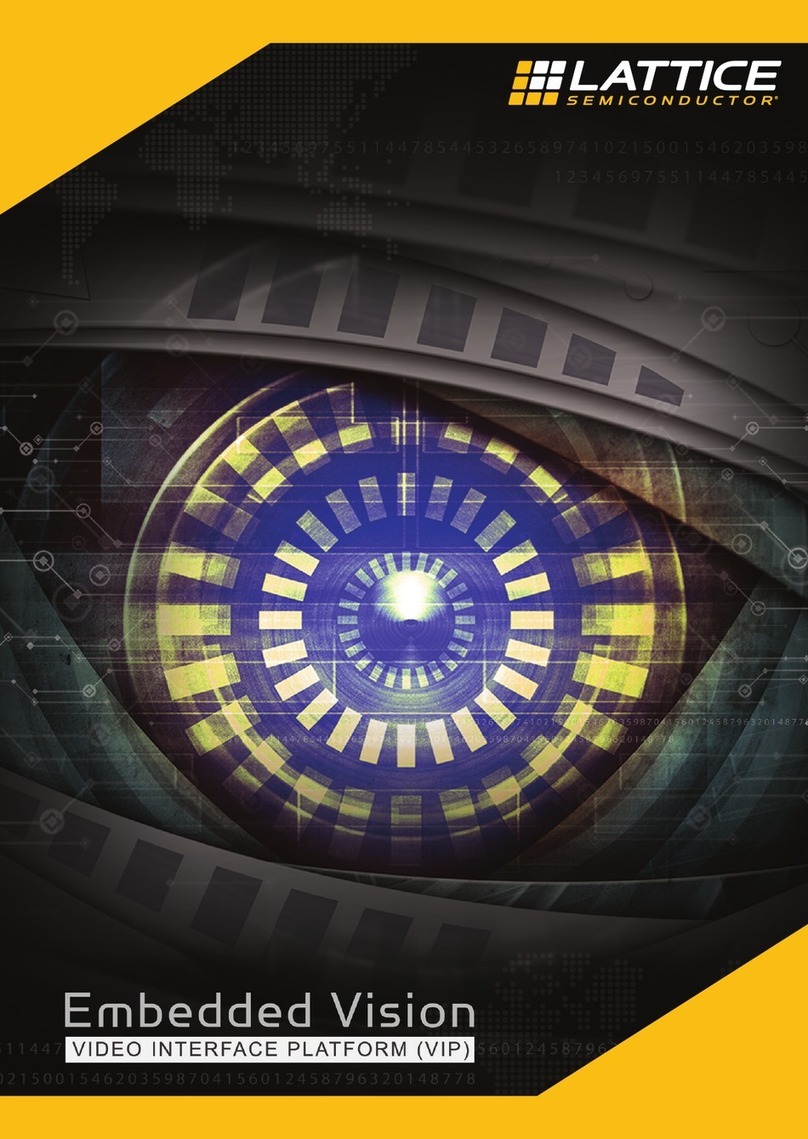
2
Lattice USB3 Video Bridge Development Kit
Introduction
The Lattice USB3 Video Bridge board allows designers to investigate and experiment with the features of the
LatticeECP3™ Field-Programmable Gate Array device in applications of transporting video and audio data through
the Universal Serial Bus (USB) 3.0 link. The Lattice USB3 Video Bridge board is the hardware platform of the Lat-
tice USB3 Video Bridge Development Kit. Combined with the control and configuration application software and
drivers, the features of the Lattice USB3 Video Bridge board can assist design engineers with rapid prototype and
validation of their specific USB3 Video Bridge designs. This guide is intended to be referenced in conjunction with
the RD1203, Lattice USB3 Video Bridge Reference Design User's Guide to demonstrate the capability and perfor-
mance of LatticeECP3 FPGA.
Features
Key features of the Lattice USB 3.0 Video Bridge Development Kit include:
• SuperSpeed USB 3.0 Interface over Cypress EZ-USB FX3 (CYUSB3014) IC
• HDMI interface over Analog Devices ADV7611 IC
• Embedded SDI Receiver interface with TI LMH0394 Cable Equalizer
• Si5338 programmable clock generator
• LatticeECP3-17 FPGA programmed with USB3 Video and Audio bridge function
• Expansion connector for Image sensors using SubLVDS or MIPI CSI-2
• Selectable expansion VCCIO
• Selectable power supply (USB or Auxiliary 5V)
• Fly-wire ispDownload cable connection for JTAG fast program and Reveal Analyzer
• SPI serial flash controlled by the FX3 USB controller
• FPGA configuration at startup by the FX3 via the ispCONFIG SPI interface
• I2C and SPI bus for onboard device controls from the FX3
• FX3 JTAG Connector
• 2-pin GPIO debug connector (LVTTL) useful for I2C or UART
General Description
The Lattice USB3 Video Bridge Development Kit is built around the LatticeECP3-17EA 328-ball csBGA FPGA
device. The board with the FPGA, peripheral devices and connectors provide a seamless USB3 bridge function for
video streaming and capturing applications utilizing the USB 3.0 USB Video Class (UVC) standard. It also supports
multi-channel I2S PCM audio streaming through the same USB3 link. The parallel video and audio interface from
the ADV7611 HDMI Receiver, the embedded CML SERDES Receiver interface, and differential I/Os on the sensor
expansion header are useful for evaluating various Lattice IP cores for video interfacing, as well as the USB 3.0
UVC bridge design. A number of test points are provided to validate various power and configuration status.
Figure 1 shows the conceptual connections between LatticeECP3 FPGA device and other peripheral components
of the USB3 Bridge board.
The contents of this user's guide include top-level functional descriptions of the various portions of the board,
descriptions of the on-board connectors, diodes and switches and a complete set of schematics.




























